The #1 Supplement EVERY Woman Needs
Are you a woman? Do you know a woman? Chances are you have experienced or are currently experiencing some form of female hormone imbalance. “No, no,” you say, “That’s not me. I’ve never had any problems.” Ever had PMS? Mood swings? Hot flashes? Unexplained hair loss or weight gain, or inability to lose weight? Low libido? Yeah, this is you, and you’ve had these problems.
We all have stress in our lives due to emotional or dietary changes or pain/hidden inflammation, and a women manifests stress throughout her body in different ways. Some of these can be mild, but sometimes it can be serious too (endometriosis or PCOS). Whatever your degree of hormonal imbalance, there’s one supplement—one marvel mineral—that can help EVERY woman.
Drum roll please…. Magnesium!

Why is it awesome?
Magnesium has over 320 functions in the body. Some of the most notable are:
- It is anti-inflammatory.
- It improves the function of thyroid hormones and insulin production.
- It is the key mineral in soothing your central nervous system and calming your HPA axis (the system in your body that deals with stress). This in turn helps with insomnia by activating the GABA (your brains main inhibitory neurotransmitter, which calms your brain cells and keeps your brain from getting overexcited) [1]. ( Check out my blog, “Here’s One that Will Put You to Sleep”)
- It promotes the healthy metabolism of estrogen.
Those who are magnesium deficient often experience these symptoms:
- Weakness
- Fatigue
- Muscle cramps
- Hypertension (high blood pressure)
- Increased inflammation
- Kidney stones
- Osteoporosis (brittle bones)
- Heart conditions and electrical disturbances
How much should I be getting?
Magnesium should be at a 1:1 ratio with is partner mineral in bone health, calcium. Everyone thinks bones are only made up of calcium, but this is not the case. Most osteoporosis/penia clients do not have a calcium deficiency, the culprit it is Magnesium. Magnesium is needed for bone structure and strength, but it also protects bone density and cardiovascular health by directing calcium toward bone and away from blood and tissues where it could cause hardening of the arteries, or atherosclerosis, according to “Human Metabolism: Functional Diversity and Integration.” Magnesium is also needed for muscle relaxation, metabolism and numerous enzymatic reactions in your body. Magnesium-rich foods include beans, seeds, nuts, fish, spinach and broccoli.
How can I find out if I have enough?
Regular blood tests do not give us an adequate picture of our mineral stores. Usually the doctor tests serum level blood tests for magnesium and potassium and they aren't really very accurate as they test what is in the blood, minerals do not store in the blood they store in the cell. The best way to test with blood is a serum, urine or hair mineral testing. Having normal magnesium on a blood serum lab test doesn't tell us if you have a deficiency of what is stored in the cell. The serum blood test only accounts for 1% of the magnesium in the body. So it is quite possible for the magnesium levels elsewhere in your body to be low but have the serum test to come back normal.
Why am I not getting what I need?
Stress causes the body to dump or use up magnesium and food cannot restore the mineral as fast as we are using it up with our stressful lives - stress comes in the form of emotional stress (good and bad) dietary stress, pain and inflammation and hidden inflammation.
We need magnesium the most during stressful periods and even though it is illogical this is when the body dumps it the most and the reason being is that by dumping it. the body is able to rev up the central nervous system so that we can deal with the stressful situation. The problem here is we are stressed all the time. We are stressed when we wake up, stressed when we eat, stressed when we rest, stressed when we work too much and when we don’t work enough, stressed about finances, money, relationships, social media, news, politics. You name it we stress about it.
Environmental toxins also steal it. You may say that you don’t experience many environmental toxins since you live in a clean neighborhood and don’t smoke. You absolutely are exposed to these toxins though! Simply put our lives are filled with environmental toxins, many of which are xeno-estrogens. These mimic estrogen and are especially harmful to a woman’s hormone balance. Here are some of the most common sources of toxins:
- Lawn care products such as fertilizer or pesticides
- Make up
- Home cleaning products
- Pesticides in food
- City water source (often filled with chemicals)
- Plastics
Simply put, toxins, stress, inflammation "steal" our magnesium.
How can I get it naturally?
Food sources[2] of Magnesium
- Spinach (157 mg per cup)
- Swiss chard (151 mg per cup)
- Beet greens (98 mg per cup)
- Sunflower seeds (114 mg per cup)
- Pumpkin seeds (190 mg per ¼ cup)
- Summer squash (43 mg per cup)
- Black beans (120 mg per cup)
- Edamame (100 mg per cup)
- Brown rice (84 mg per cup)
- Baked potato (43 mg per 3 ounces)
- Avocado, cubed (44 mg per cup)
- Broccoli (24 mg per cup)
The food supply is lacking though. We no longer can get an adequate amount and high quality of nutrients just through our food because our soil and water have been over farmed and are stripped of minerals. You probably can’t eat enough magnesium rich foods to truly supply yoru body with the kinds of magnesium and amounts it needs. That’s why I suggest supplementing. Make sure to use a supplement that is high-quality and professional grade. You don’t want to be spending money on fillers and supplements that don’t do much supplementing.
What supplements are available to make sure I get enough?
There are many different forms of magnesium. Find a list HERE [3]. I recommend Magnesium Glycinate most often because it directly helps the central nervous system regulate which in turn helps you feel less stressed! A general guide would be to take 350 mg per day taken at different time of the day - so 100-125 mg per dose at breakfast, lunch, dinner is best for absorption and to calm the central nervous system. Biotics and Nutri-Dyn are two of my favorite, trusted brands. Both are high-quality and professional grade while being manageable on your budget. Here are a few other magnesium supplements that I often recommend to my clients
- Magnesium Glycinate - This form is most helpful for stress relief.
- Mg-Zyme - Very similar to the form above but also has magnesium aspertate and magnesium gluconate.
- Magtein - Also supportive of the brain since it contains magnesium L-threonate which is the only form of magnesium known to cross the blood-brain barrier.
- Mag-K or Potassium-HP with Magnesium - This is a magnesium and potassium combination supplement which is helpful since potassium is often deficient along with magnesium.
I also often avoid magnesium citrate. Although this form can be helpful for some people, it doesn’t store in the body and pulls water into the intestines. It can make you dehydrated and cause problems that come with dehydration. It also can mess with proper copper storage.
When should I NOT take it?
Times not to take magnesium is if you have kidney disease. Always consult with your doctor of healthcare professional before taking any supplements since they will know how a particular supplement will interact with other medications or health conditions.
You can’t live without magnesium and ensuring you have a proper balance of magnesium in your body will optimize the life you want to live. If you think you are out of balance, chances are you have other minerals thatt are imbalanced as well. The
Hair Tissue Minearal Analysis (HTMA) is the golden key test I use to learn all about mineral status in the body. Schedule a
Health Discovery Session to learn more about this test and the best options for your body to balance hormones, body systems and achieve the optimized life you dream of living.
Sources
- https://www.ncbi.nlm.nih.gov/books/NBK507254/
- https://ods.od.nih.gov/factsheets/Magnesium-HealthProfessional/
- https://www.vitacost.com/blog/vitamins-supplements/supplements/types-of-magnesium.htm
Don't Miss Out!

Heidi Toy Functional Medicine Blog





























































































